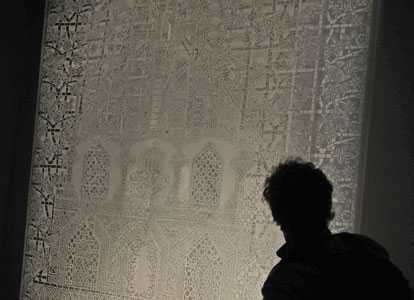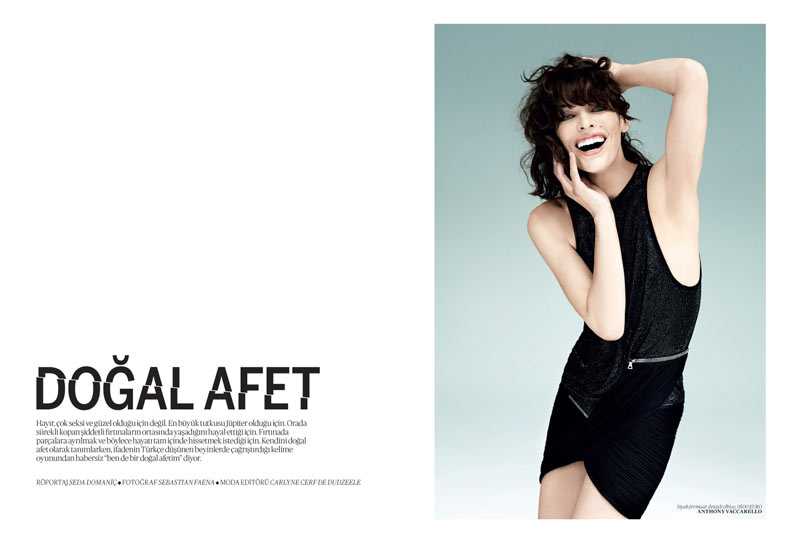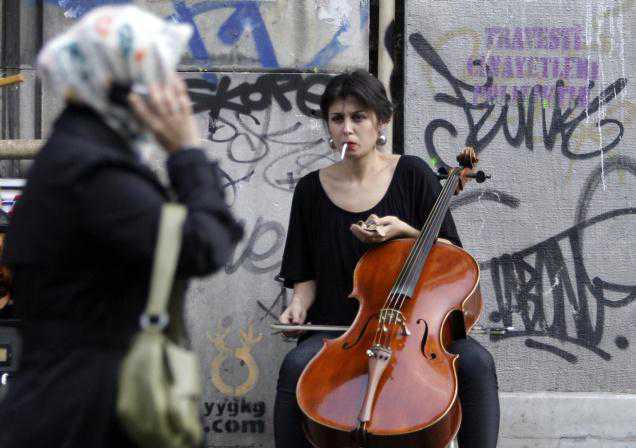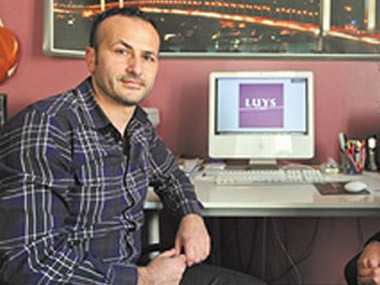
Holy Ghost ©2003 Trici Venola
THE HEART CHURCH I sat in chill near-darkness at the bottom of a natural stone formation shaped like a fat rocket ship about to take off. I felt perfect peace, and the silence sang. I felt veins of power surging up around me from a point in the bones of the earth directly below, throbbing up to converge again at the point in the sky. I thought of those ‘Sixties pyramid people, claiming that a pyramid shape brings together mystic geological forces. I believed them for the first time.

I was down in the bottom chapel, below ground, in a rock formation that has been a church since early Christianity. Someone long ago painted the darkness white with little red hearts on it. It was almost too dark to draw at all but I tried. There were graves cut in the floor, their occupants long gone to dust. I could lie here in the dark, I thought, in this singing silence, feel my bones become one with the earth, content for all eternity. But –like that line in Gladiator– NOT YET!!

The Heart Church ©2006 Trici Venola
I can’t die yet, there’s too much to draw. Much of it here in Kapadokya, the central steppes region of Turkey, a spiritual refuge. Everyone else in the world spells it Cappadocia and pronounces it with a soft final “c,” but since the original name– Katpatuka in Old Persian– means Land of Beautiful Horses, and Kapadokya sounds like a galloping horse, and that’s what the people who live there call it, I use Kapadokya.

Cold Hill Caves ©2006 Trici Venola
Those hearts, by the way, look like a natural abstraction of apricot leaves. There are a lot of apricot trees here.

First-time readers might enjoy the previous post, which is an overview of Kapadokya’s history and my first trip to the place in 1999. I loved it on first glance and have continued to come back for close-ups, like this one of a kid with a Biblical name become Turkish, in a ruined rock church with a vanishing saint.

Zekeriya and A Saint ©2003 Trici Venola
Spring is here and there’s so much to be done. High Season is upon us here in Istanbul: hotels filling up, all the monuments jammed, monstrous cruise ships blocking the views, throngs trooping through the bazaars. Some of my friends, in shops and hotels, don’t sleep again until winter. There are all kinds of projects to finish immediately, and only me to do them. And all I can think about is that just about now, in Kapadokya, beneath the sheer rock walls punctuated with caves, the high grass in the bottoms of the canyons is shooting up green, and the drifts of cottonwood blossoms on the ground can be combed with your eyes. So fooey on all these Istanbul distractions. I’m back to Kapadokya, and I’ve got you with me.

Nine AM, and the sun full in my face. The air sharp and glittering, little flies everywhere. Only the drawing kept me from going nuts with them. I squinted into the white under a giant scarf rolled like a turban, and drew and drew.
While Kapadokya is full of former tourists who fall in love with the place and buy up all the caves, the locals mostly want to move into cheesy apartment buildings just out of town. Some families still live in caves.

I climbed up the mountain above Urgup one morning and was struck with an obviously occupied cave complex. A seamed dark woman, shaped like a pillow tied in the middle, came out to hang up her laundry. Awhile later, a young beautiful echo of her stumbled out sleepy into the morning and found me drawing her house and her mother.

Gunik in the Morning ©1999 Trici Venola
After the two-hour drawing session they invited me into the house for tea. Inside it was big and clean, with plastered walls, electricity and plumbing, lace curtains at the little square windows cut in the hill. I imagined all the empty caves I’ve seen, filled with lively people. Friends who grew up in caves describe scooting up and down the ladders between, calling between the caves, the cosy enclosed feeling of a cave with a fire pit, the way every little thing has its own alcove. I know I sleep better in a cave than any other place, deep perfect sleep all the night long.

The View from Uchisar ©2007 Trici Venola
GREEKS AND TURKS This land is beyond ancient. A thousand armies have trekked through here:. Hittites, Romans, Armenians, Seljuks, Greeks. Arab raiders in the 7th and 8th centuries drove the Christians into underground Hittite cities, converting chapels to pigeon coops and painting designs all round the pigeonholes.

Christians came up from underground and repainted frescoes in the cave chapels before decamping a few centuries later. Some Greek Christians stuck it out until the population exchange in the 20th century, building square houses of embossed brick like this one in Mustafapasa.

Kid in Mustafa Pasa ©1999 Trici Venola
The Christian monasteries here were Greek, and the Byzantine Christians were the genesis of what we now know as Greek Orthodox. All across Anatolia the Greeks left their buildings, temples and myths; a few of their descendents are still here as Turks.
 The 20th century brought about a great dissolution of the centuries-old relationship of Greeks and Turks in both countries, scars which are still healing. Reading Louis de Bernieres’ Birds Without Wings broke my heart but fed my understanding. Two governments, two faiths, but one people. It’s everywhere: in the music, the food, the way the people look and the way they dance. I hope that this century brings about greater harmony than the last.
The 20th century brought about a great dissolution of the centuries-old relationship of Greeks and Turks in both countries, scars which are still healing. Reading Louis de Bernieres’ Birds Without Wings broke my heart but fed my understanding. Two governments, two faiths, but one people. It’s everywhere: in the music, the food, the way the people look and the way they dance. I hope that this century brings about greater harmony than the last.

Old Couple in Ayvali ©1999 Trici Venola
THE BIG CHURCH Are you ready for this place? It was March 2006 and cold enough to numb your hands in gloves, but there wasn’t any question of missing these drawings. Now called Durmus Kadir after its owner, this great stone basilica is a premier example of Goreme’s legendary 1001 cave churches.

Big Church in Goreme ©2006 Trici Venola
Like all cave chapels Durmush Kadir’s interior is carved out of the rock all of a piece: a sculpture of a church to emulate the diverse columns, alcoves, domes, altars and pulpits in a conventionally constructed church elsewhere.

The Podium ©2006 Trici Venola
This one gets a lot of action. Months later in Istanbul, a woman looking through my sketchbook suddenly let out a yelp and pulled out a photo of herself getting married on this very podium. Today the area in front of Durmush Kadir is much spiffed-up, presumably to make it attractive for events. Across the valley is this apartment, replete with carvings.

The Guest Room ©2006 Trici Venola
Spacious inside, It looks like a VIP suite to me. During the Middle Ages, Goreme was the seat of enormous ecclesiastical power. Ecumenical councils were held here. Pilgrims journeyed from all over to convene here.

Thousands of monks tilled these fields, tending the huge flocks of pigeons. Valued for their dung, which still fertilizes all the food grown here, and for their messenger abilities, pigeons are treasured here still. Below Durmush Kadir’s church is a refectory, where hundreds of cowled monks sat for their supper. The drawing below was done through a chain-link fence. That modern wall marks the present property line.

Refectory ©2006 Trici Venola
IN TOWN Pat Yale, justly famed for her wonderful travel books about Turkey, lives in Goreme with about nine cats, and in 2006 I was lucky enough to house sit. Not only did I get all these swell drawings, but two of the cats kittened while I was there, giving us a grand total of fourteen. The cats midwifed for each other, too.
 Something about the details in the monochromatic landscape makes Kapadokya perfect for the kind of work in this series, and I can’t stop drawing. So I sat in the street and drew this:
Something about the details in the monochromatic landscape makes Kapadokya perfect for the kind of work in this series, and I can’t stop drawing. So I sat in the street and drew this:

Two Hats in Goreme ©2006 Trici Venola
I had company in the street. For two hours she watched me draw those two hats, and then she posed unblinking, glinting up at me, until I had her, including that fabulous shadow of the oya scarf trim on her face. “Gotcha,” I said, and showed her. She nodded violently and vanished. On one of Pat’s walls is an antique pink cotton quilted jacket, very worn. It’s a classic Kapadokya jacket worn by a woman who lived and died here long since. I picture it on someone like this.

Mischief ©2006 Trici Venola
PAINTING IN THE DARK: THE GENESIS OF MONASTIC LIFE Kapadokya has been protected since the advent of Tourism in the 1980s. Preserved from destruction-by-development, the land here can be observed shedding itself, sloughing off and renewing. Caves last a long time, and then one day they collapse, or erosion finally eats them away. It’s the nature of this rock to shed. Dust is a part of life here. If you move into a cave, stabilizing the walls (with the help of a local expert) is a good idea. Some of these chimney chapels are so old they’re almost gone, with only the keyhole-shaped alcove or window as a clue that here is a witness to so many prayers.

Eroded Monument ©2011 Trici Venola
The monolith above was once a chapel at the intersection of the main road with the path leading down to the river. Below, Laura Prusoff and her partner Nurettin look across Pigeon Valley from their Palace in Ortahisar. Over the years I’ve drawn their view quite a few times. My reward is that I can close my eyes and see it in all its grandeur. The shadows paint a new shape every few minutes, making a drawing of several hours a very different thing from a photograph.

Lions in the Valley ©2003 Trici Venola
I didn’t realize that the whole of Pigeon Valley was a monastery. It took a long time of looking, and then I could see it.

The Christians were here from the beginning of Christianity. St Paul came through Kayseri– once Caesarea– on his way to Ankyra, now Ankara, carrying Christianity with him. It found fertile ground in Kapadokya, now full of ecclesiastical ruins, abandoned by the Christians around the 15th century in the teeth of Islam. This bas-relief figure is the only one in Kapadokya. “It’s a devil,” said my friend. “But it looks like an angel,” I said. “No, it’s always my whole life been called a devil,” he said.

Now It’s Called A Devil ©2011 Trici Venola
Goreme sits between two valleys full of natural stone formations, many with Early Christian cave churches, part of a vast monastery complex with influences reaching across oceans and continents. By the 4th century, the Cappadocian Fathers were an ecclesiastical force to be reckoned with, forming much early Christian philosophy.
 The very template for monastic life was cut in these rocks by St Basil, a highly educated 4th century cleric who renounced a promising career in Constantinople and Athens to become a monk. As such he became a hermit in Kapadokya, where he was joined by Future Saint Gregory of Nazianzas. I like to think of these two wearing down the stones under their knees, sallying forth in cold and snow and scorching sun, tending the fields, the flocks and the Word. They were joined by many others.
The very template for monastic life was cut in these rocks by St Basil, a highly educated 4th century cleric who renounced a promising career in Constantinople and Athens to become a monk. As such he became a hermit in Kapadokya, where he was joined by Future Saint Gregory of Nazianzas. I like to think of these two wearing down the stones under their knees, sallying forth in cold and snow and scorching sun, tending the fields, the flocks and the Word. They were joined by many others.

A FIeld of Sunflowers ©2011 Trici Venola
In 370 Basil became Bishop. A charismatic leader and great organizer, he reformed the Liturgy, established hospitals, and fostered monasticism as a way of life: chastity, dedication, seclusion, submersion of the single in the whole. These ecclesiastical troglodytes made the land their church. Cells, offices, stables, kitchens, cafeterias, dormitories, chapels, churches, wineries, hospitals: all were caves.

The Hospital Monastery 2011 Trici Venola
THREE MORE CHURCHES Yusuf Koc is in a cluster of chimneys out in Goreme Valley, just outside the town. A local family lives in them and tends the churches as they always have.

Goreme Valley Longshot ©2006 Trici Venola
Before the advent of Tourism, folks just sumped out their own caves. Now they police them as well, with assistance from the State.

Another Freezing Jesus ©2006 Trici Venola
Boy, was it cold in there. I wonder if the monks had braziers or if they depended on crowds for warmth. This chapel had columns, but was pressed into service as a pigeon-house in pre-tourism. The columns were broken off, but the frescoes preserved with only a little graffiti. See the pigeonholes built into the window?

This was painted after the 9th century. The monochromatic and geometric painting in many caves is Iconoclastic art. The Iconoclasts, like the Muslims, proscribed pictorial art. They were around for about 100 years, in the latter 8th and early 9th centuries. But this is pictorial and multicolored. and the state of preservation tells us it’s post-Iconoclast. Here are two archangels on horseback. See the wings?

Painting in the Dark ©2006 Trici Venola
I love this Naive Byzantine painting. Anatomically it’s more symbolic than realistic. Artistic anatomy peaked with the late Roman period, when the body was a still a temple. Medieval Christians were suspicious of the body, seeing it as a fount of temptation. The monastic life was about eschewing physical pleasures in favor of devotion to the divine. This is reflected in the art of the time: bodies lost under cloth or armor, an insouciant attitude towards proportion and gravity. Then again, considering that these caves are pretty darn dim inside, I wonder they could see to paint at all.

Up top in Pigeon Valley is a Black Church: fire has blackened the inside. Notice the bas-relief cross on the sooted ceiling to the right, revealed by the erosion at the window.

The Black Church ©2006 Trici Venola
I crawled up through this opening and crouched on a big old earth spill up under the domes to get this next drawing. We know that this chapel was carved after the 6th century because of these domes. Hagia Sophia’s great dome, so big it was considered proof of the existence of God, was completed in 537 and influenced the entire Christian world. Henceforth we see domes everywhere in Christianity, including here.

Inside the Black Church ©2006 Trici Venola
This next one isn’t the last church in the valley, it’s just the last one I could get to before dark.

The Last Church ©2006 Trici Venola
There are hundreds of hidden chapels in the rocks. Locals know and don’t tell, and this makes me happy. I like to think there’s some mystery left in the world. Here’s the inside. I had twenty minutes until dusk, did what I could, took a photo and finished from that.

Inside the Last Church ©2006 Trici Venola
This geometric Iconoclastic painting was done in cochineal –insect– blood. It’s still red, And is that an Egyptian-type Eye of God there above the doorway?

Sweeper in Goreme © 1999 Trici Venola
FAITH IN HUMANITY It was Nurettin who got me to put my sketchbooks in Koran covers, clear back on my first visit in 1999. “You should do something,” he said through Laura, “to let people know how important, how precious, this work is.” This was after the wife of a local politico grabbed my sketchbook and left it open and forgotten in her lap while she drank tea and chattered and I sat angry and anxious and afraid of offending her until mercifully they left and I took back the sketchbook. “Why didn’t you say something? People are ignorant,” said Nurettin, “They don’t understand original art.”
 On returning to Istanbul I took his advice. In the Grand Bazaar I found a pile of Koran covers in all sizes and colors, each pieced together by some shepherd or caravan housewife to keep a Koran covered, as all precious things are in Islam. I still buy as many of the right size as I can find, and they hold the original sketchbooks to this day.
On returning to Istanbul I took his advice. In the Grand Bazaar I found a pile of Koran covers in all sizes and colors, each pieced together by some shepherd or caravan housewife to keep a Koran covered, as all precious things are in Islam. I still buy as many of the right size as I can find, and they hold the original sketchbooks to this day.

Faith is a powerful force. If enough people believe in a certain way, it can change things. St Basil saw this, encouraging young men to subvert their individuality and become monks: cells in a great working mechanism of faith. The land he chose was already hallowed. It’s been holy land since the beginning of time, and I swear you can feel it. It likes us. The air is good. The water keeps you healthy. The caves offer comfortable shelter, staying around 72 degrees Fahrenheit winter and summer. The rock is easy to carve. The land yields, providing soil, fertilizer, minerals, and an absence of earthquakes. Something about the place focuses faith, whatever that faith may be.

There’s a sense of humor. The ancient gods are still here, laughing at us. In this region that was filled for centuries with young men trying mightily to ignore the blandishments of the physical, the land looks like nothing so much as the bared and hairy hillocks, planes, rolling curves and startling appendages of a great body, a constant reminder that we are humans on earth, our home. Kapadokya seems to conspire to strengthen this sense of belonging and inclusion, for this is the one thing we all have in common regardless of belief: our humanity.

Balloon Over the Valley ©2007 Trici Venola
—-
All drawings Plein air. All art from the Drawing On Istanbul™ Project by Trici Venola. All photos © Trici Venola. All art sketchbook format, mostly 7″ X 20″ / 18 cm X 52 cm, done with drafting pens on rag paper. The Drawing On Istanbul Project is independent of any institution. %
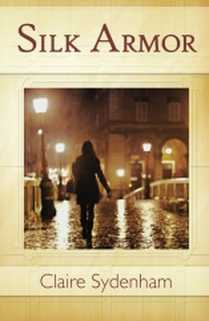














 The 20th century brought about a great dissolution of the centuries-old relationship of Greeks and Turks in both countries, scars which are still healing. Reading Louis de Bernieres’ Birds Without Wings broke my heart but fed my understanding. Two governments, two faiths, but one people. It’s everywhere: in the music, the food, the way the people look and the way they dance. I hope that this century brings about greater harmony than the last.
The 20th century brought about a great dissolution of the centuries-old relationship of Greeks and Turks in both countries, scars which are still healing. Reading Louis de Bernieres’ Birds Without Wings broke my heart but fed my understanding. Two governments, two faiths, but one people. It’s everywhere: in the music, the food, the way the people look and the way they dance. I hope that this century brings about greater harmony than the last.





 Something about the details in the monochromatic landscape makes Kapadokya perfect for the kind of work in this series, and I can’t stop drawing. So I sat in the street and drew this:
Something about the details in the monochromatic landscape makes Kapadokya perfect for the kind of work in this series, and I can’t stop drawing. So I sat in the street and drew this:





 The very template for monastic life was cut in these rocks by St Basil, a highly educated 4th century cleric who renounced a promising career in Constantinople and Athens to become a monk. As such he became a hermit in Kapadokya, where he was joined by Future Saint Gregory of Nazianzas. I like to think of these two wearing down the stones under their knees, sallying forth in cold and snow and scorching sun, tending the fields, the flocks and the Word. They were joined by many others.
The very template for monastic life was cut in these rocks by St Basil, a highly educated 4th century cleric who renounced a promising career in Constantinople and Athens to become a monk. As such he became a hermit in Kapadokya, where he was joined by Future Saint Gregory of Nazianzas. I like to think of these two wearing down the stones under their knees, sallying forth in cold and snow and scorching sun, tending the fields, the flocks and the Word. They were joined by many others.











 On returning to Istanbul I took his advice. In the Grand Bazaar I found a pile of Koran covers in all sizes and colors, each pieced together by some shepherd or caravan housewife to keep a Koran covered, as all precious things are in Islam. I still buy as many of the right size as I can find, and they hold the original sketchbooks to this day.
On returning to Istanbul I took his advice. In the Grand Bazaar I found a pile of Koran covers in all sizes and colors, each pieced together by some shepherd or caravan housewife to keep a Koran covered, as all precious things are in Islam. I still buy as many of the right size as I can find, and they hold the original sketchbooks to this day.


